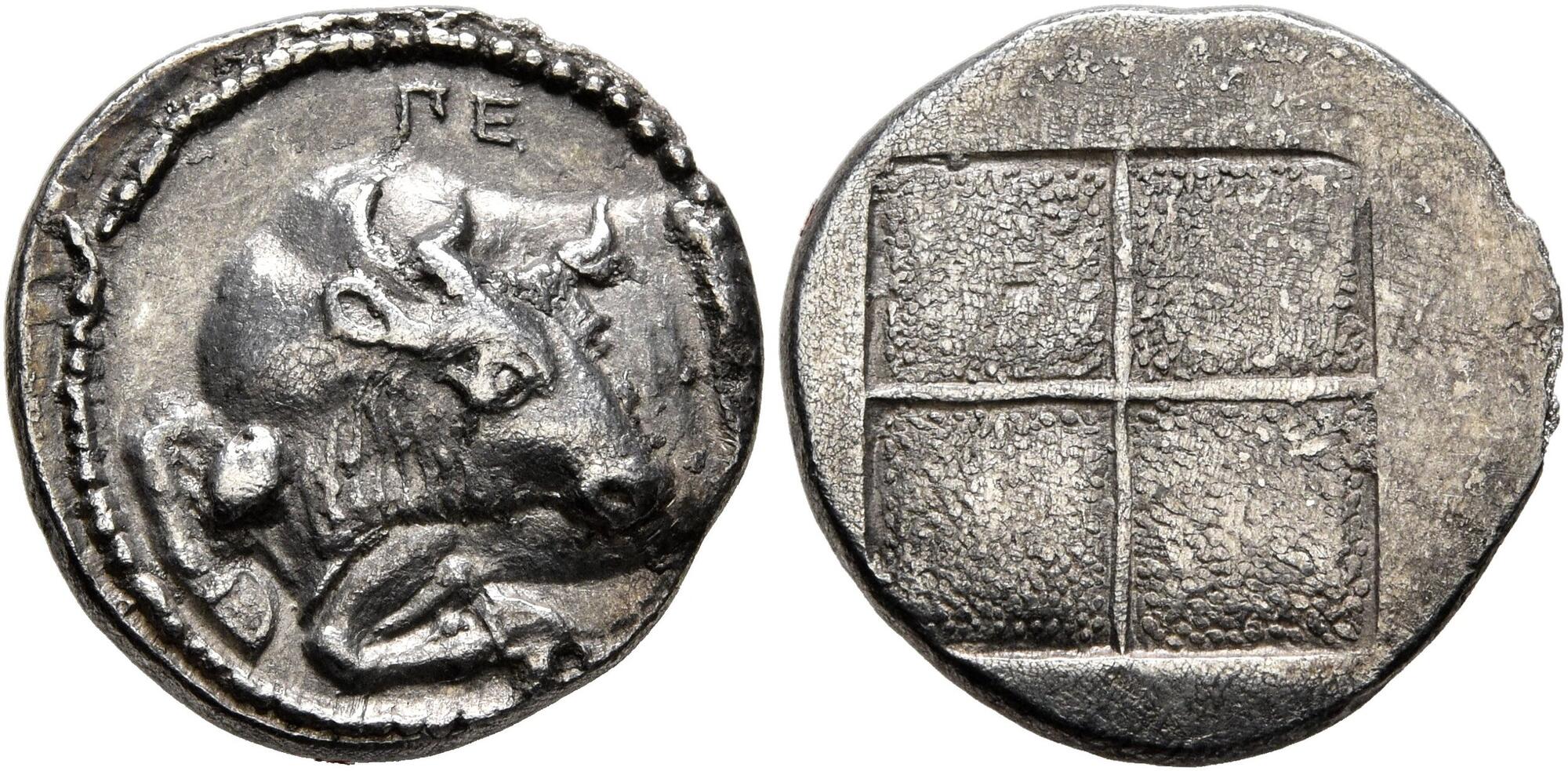S 1820 - Acanthus, silver, tetrobols (Period F) (430-380 BCE)
From SILVER
430 BCE - 380 BCE Silver 9,087 kg
Description
| ObverseInscription or printing placed on the obverse.: | above, ΠE (Greek).Forepart of a bull to left, head turned back to right |
| ReverseInscription or printing placed on the reverse.: | Quadripartite incuse square with granulated recesses |
Mint and issuing power
| MintIdentifies the place of manufacture or issue of a numismatic object.: | Acanthus | Ancient regionAncient region.: | Macedon | Modern countryModern country: Greece | AuthorityIdentifies the issuing power. The authority can be "pretended" when the name or the portrait of X is on the coin but he/she was not the issuing power. It can also be "uncertain" when there is no mention of X on the coin but he/she was the issuing power according to the historical sources: |
Chronology
| FromIdentifies the initial date in a range assigned in a numismatic context. | 430 BCE | toIdentifies the final date in a range assigned in a numismatic context.. | 380 BCE | PeriodTime period of the numismatic object.: Classical 480-323 BC |
Physical description
| MetalThe physical material (usually metal) from which an object is made.: | Silver |
Median weightMedian of the weights of numismatic objects (in grams). in grams | 2.30 | DenominationTerm indicating the value of a numismatic object. Examples: tetradrachm, chalkous, denarius.: | tetrobol |
StandardStandard.: |
Image

S1820 Acanthus tetrobols F-G.jpg [1]
References
| Die study referencePublication of the study: | Tselekas 19961Tselekas 1996, p. 266-295 and 306-309 | ||
| Coin series referenceReference to coin series study: | HGC 3.12HGC 3.1, n° 392 | ||
Obverse dies distribution
| FrequencyFrequency of specimen in distribution. ᵖ | Number of obversesNumber of obverse dies. ᵖ (o) | % (o) | Number of coinsNumber of coins. (n) | % (n) | Die nameName(s) of the die(s). |
| 1 | 73 | 44.51 | 73 | 12.61 | 94, 98, 100, 101, 102, 107, 112, 113, 117, 118, 120, 121, 122, 123, 125, 126, 128, 130, 132, 133, 134, 136, 137, 138, 141, 143, 146, 149, 162, 163, 164, 165, 166, 168, 171, 175, 177, 182, 186, 189, 191, 193, 194, 195, 196, 197, 198, 199, 200, 201, 203, 205, 206, 207, 208, 209, 210, 211, 212, 213, 214, 216, 222, 223, 224, 225, 226, 227, 229, 233, 236, 244 |
| 2 | 16 | 9.76 | 32 | 5.53 | 91, 110, 111, 114, 129, 142, 148, 153, 154, 167, 187, 204, 228, 235, 238, 239 |
| 3 | 18 | 10.98 | 54 | 9.33 | 87, 115, 116, 135, 140, 155, 159, 169, 170, 190, 202, 215, 217, 218, 221, 234, 237, 242 |
| 4 | 13 | 7.93 | 52 | 8.98 | 88, 103, 109, 119, 158, 173, 176, 179, 219, 220, 232, 241, 245 |
| 5 | 8 | 4.88 | 40 | 6.91 | 104, 124, 127, 131, 147, 156, 230, 247 |
| 6 | 7 | 4.27 | 42 | 7.25 | 84, 92, 97, 172, 178, 188, 240 |
| 7 | 11 | 6.71 | 77 | 13.3 | 89, 93, 95, 105, 139, 144, 151, 152, 183, 192, 246 |
| 8 | 2 | 1.22 | 16 | 2.76 | 86, 106 |
| 9 | 5 | 3.05 | 45 | 7.77 | 90, 108, 145, 161, 231 |
| 10 | 5 | 3.05 | 50 | 8.64 | 85, 160, 174, 181, 185 |
| 12 | 1 | 0.61 | 12 | 2.07 | 150 |
| 13 | 2 | 1.22 | 26 | 4.49 | 157, 180 |
| 14 | 1 | 0.61 | 14 | 2.42 | 99 |
| 16 | 1 | 0.61 | 16 | 2.76 | 96 |
| 30 | 1 | 0.61 | 30 | 5.18 | 184 |
| Total | 164 of 164 | 100.02 | 579 of 579 | 100 |
Reverse dies distribution
no distribution is available
Quantification
| Number of obversesNumber of obverse dies. ᵖ (o) | 164 | Number of singletons (o1)The number of singleton coins. ᵖ | |
| Number of reverse diesNumber of reverse dies. (r) | 166 | Number of coinsNumber of coins. (n) | 579 |
| Coins per obverse dieNumber of coins per obverse die. (n/o) | 3.53 | Coins per reverse dieNumber of coins per reverse die. (n/r) | 3.49 |
| Reverse per obverse ratioRatio of obverse dies divided by reverse dies. (r/o) | 1.01 | Percentage of singletons (o1)number of coins (n) divided by the number of singletons (o1) ᵖ | % |
| Original number of dies (O) (Carter 1983 formula)The estimation of the number of coins according to Carter 1983 ᵖ | 197.54 | Coins struck if 20,000 as average productivity per dieCoins made if the average productivity for obverses (according to Carter) is 20,000. ᵖ | 3,950,800 |
| Original number of dies (O) (Esty 2011 formula)The estimation of the number of coins according to the singleton formula in Esty 2011 ᵖ (O) | 228.81 | Survival rate if 20,000 as average productivity per dieSurvival rate if average productivity is 20,000. ᵖ | 0.00015 |
| Coverage (o = % of O) (Esty 1984 formula)Esty 1984 - coverage (% of O) ᵖ (o = % of O) | % | Die productivity if survival rate 1/2,000Average productivity if survival rate is 1/2,000. ᵖ | 5,862.1 |
| Weight of silver (in kg) if 20,000 coins per die (O = Carter formula)Carter 1983 * Median weight * 20000 (*10 if gold or electrum) ᵖ | 9,087 kg <br /> 9,087 kg | Die productivity if survival rate 1/5,000Average productivity if survival rate is 1/5,000. ᵖ | 14,655.26 |
Remarks